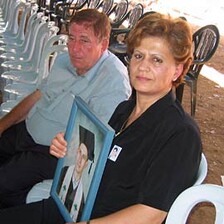The Electronic Intifada 23 September 2005

The Wall around Qalqiliya. A twenty-five foot high concrete cage cuts residents off from their agricultural land, necessary for their survival, and prevents you from traveling even 5 minutes out of the City. A single gate, open at the whims of the occupying army, controls 100,000 residents.
It is only a matter of time before West Bankers start blasting holes in the wall Israel has built to contain and squeeze their movement through “corridors”, as though they were cattle. Right now, they seem to be satisfied with spraying graffiti on the wall and painting whimsical scenes of ladders and windows or representations of holes. On the Gaza Strip, in the fine tradition of great prison-escape movies, Hamas blasted a hole in the wall north of Rafah a few days ago to help people through. Islamic Jihad blasted a hole about a mile down the wall shortly after that. Following this, the great escape at the Gaza-Egyptian border unfolded: “After hours of pushing and shoving at the Saladin border crossing in Rafah, the police line broke and hundreds of Palestinians crossed the border. Faced with the large crowds, many policemen gave up and the crossing became almost as open as it was in the past days.”
In the face of this exuberant escape, Israel’s foreign ministry could do nothing but hold up the spectre of terrorism in every shape and form its spokesman could possibly imagine: “We’re talking about Iran, we’re talking elements in Syria, we’re talking about groups like Hizbollah and we’re talking also about international terrorist groups like Al Qaeda.”
We are talking about a GDP in Gaza lower than Afghanistan’s, where 65 per cent of the strip’s 1.3 million Palestinians live below the poverty line. As it turned out, the Gazans were simply going shopping in Egypt with what little money they had — until, that is, prices rose on the Egyptian side in response to demand matching prices inside the Gaza Strip. Sick with years of restricted movement and restricted Israeli-issued prison fare, Gazans flocked through the holes in the wall to get provisions for their families and to visit relatives on the other side from whom they had been separated for years.
Yes, some also armed themselves with Egyptian-made pistols. Israel imports its weapons mainly from the US. On April 27, 2003, the Israeli high court issued a decision that effectively permitted Israeli military forces to use flechette anti-personnel tank shells against Palestinian civilians. These weapons are designed to injure or kill indiscriminately by spraying metal shards across as wide an area as possible. (I mention this here, since Israel’s foreign ministry is directing the world’s attention to the subject of terrorism.)
Back to Gaza. A Washington Post editorial looked at the scenes of release in Gaza through an Israeli prism, blaming President Mahmoud Abbas for “allowing mobs of looters and armed extremists” to “rampage” through former Jewish settlements, and to burn, bulldoze and strip what had been left standing. Islamic Hamas does not want Israeli leftovers, nor will it look kindly in future on other Israeli entrepreneurial visions such as Samuel Flatto-Sharon’s proposed 400-room hotel and casino on the former Israeli settlement of Elei Sinai. “Palestinians will man the gaming tables,” he says. “In one month, these people will know how to deal blackjack. We can make a lot of money.”
Watching the scenes of release described above, as Gazans poured through the border with Egypt, millions of people in Palestine and the Middle East as well as around the world stood up and cheered the Palestinians, just as one would at the climax of a great escape movie when the prisoners finally get the better of their captors. Yes!
But this particular film is directed by Sharon who subscribes to the auteur theory of filmmaking which views a director as the primary creative force or “author” of a film. The executive producer of the film, the US government, also unfortunately subscribes to this theory.
As Israel continues to create “realities on the ground” in Ma’aleh Adumim and elsewhere, in order to preempt final status negotiations, as it interferes with the Palestinians’ upcoming January parliamentary elections insisting that Hamas be excluded from the political process, the US remains solidly behind it.
Sharon quickly turned the scene of the Gazans’ great escape into his favourite motif. According to him, the Palestinians’ exuberant but short-lived escape through the blasted hole in the wall shows that they are unworthy of joining the community of nations. No further territorial withdrawals or other “concessions” will be afforded them. Back to the corner they must go until they prove themselves. Let them deal blackjack.
In the framework of the auteur theory, the director leaves the mark of his personality on the film and calls every shot. The Palestinians are not even minor characters in Sharon’s film; at best, they are faceless extras. And the personality of the director? A murderer and a liar, the butcher of Sabra and Shatilla.
Rima Merriman lives in Ramallah in the occupied West Bank





